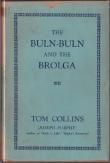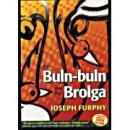AustLit
Latest Issues
AbstractHistoryArchive Description
The Buln-buln and the Brolga is a long story that is a revised and expanded version of the second chapter of the original Such is Life. The action takes place in the township of Echuca where the narrator, Tom Collins, is waiting to meet a representative of the firm for which he works. While waiting for his associate to arrive, Collins meets a childhood friend, Fred Falkland-Pritchard, the titular buln-buln or lyrebird, so-called because of his reputation for lying. Tom also meets Barefooted Bob, the titular brolga. The three spend an evening together with Fred's wife, and the two swap yarns. Fred's yarns get taller and taller, but Bob accepts them as the truth, as Fred's wife has done throughout their marriage. Bob tells stories of violent encounters with Aboriginal people on the frontier, delivered with a bluntness that intrigues Mrs Falkland-Pritchard. The story can stand on its own as a study of an individual's perception of reality, specifically the fiction of reality or the reality of fiction. But it retains intriguing links to its original version in the typescript, made even more so by Furphy's methods of transferring sections of text during revision.
Publication Details of Only Known VersionEarliest 2 Known Versions of
Works about this Work
-
Interspecies Mateship : Tom Collins and Pup
2013
single work
criticism
— Appears in: JASAL , vol. 13 no. 1 2013;'This essay examines the representation of dogs, especially Pup in the novels of Joseph Furphy.' (Author's abstract)
-
Furphy as (Metafictive) Aboriginal Ethnographer
2013
single work
criticism
— Appears in: JASAL , vol. 13 no. 1 2013;'This paper investigates Furphy’s ethnographical writings on Aborigines in the short essays and paragraphs he wrote for the Bulletin and in one of his short stories. It also examines his representation of Toby', an 'Aboriginal stockman in Such is Life, and concludes by examining one of the most difficult passages in a colonial era novel, his account of a Palmer River Aboriginal attack, cannibalism, and settler murder in The Buln-buln and the Brolga. These Aboriginal-focused narratives are told as part of a suite of realistic tales by Barefooted Bob and Tom Collins, by way of counter-narrative to Fred Falkland Pritchard’s fantastical romance/action tales which belong to the ripping yarns/Boy’s Own tradition. The paper argues that, although the narrative method, in its refusal to editorialise, is uncharacteristically and unnervingly oblique, there is more than a little of Lilian Pritchard, the Lady Novelist, in Furphy himself and that the questions he puts into the mouth of the Lady Journalist about Aboriginal culture are probing and pungent.' (Author's abstract)
-
Cannibalism and Violence in Furphy's The Buln-Buln and the Brolga
2004
single work
criticism
— Appears in: The Australian Journal of Irish Studies , vol. 4 no. 2004; -
Available Furphies
2002
single work
column
— Appears in: Antipodes , June vol. 16 no. 1 2002; (p. 73) -
The Bush Hamlet
2002
single work
review
— Appears in: The Times Literary Supplement , 28 June no. 5178 2002; (p. 27)
— Review of Joseph Furphy : The Legend of a Man and His Book 1944 single work criticism ; The Buln-Buln and the Brolga 1948 single work novella'The cover of this facsimile reprint of Miles Franklin’s 1944 biography of Joseph Furphy proclaims: “The man who wrote Such Is Life . . . by the woman who wrote My Brilliant Career.” Inside, Franklin tells us that “Furphy’s book has come to serve as the touchstone for the Australian literary intelligentsia because, by his feeling for it, any literary Australian betrays whether he lives in a state of Australian grace or in one of mental colonialism.” Today, a year after the centenary of My Brilliant Career and one before that of Such Is Life, Franklin and her novel are much better known in Australia and…' (Introduction)
-
The Bush Hamlet
2002
single work
review
— Appears in: The Times Literary Supplement , 28 June no. 5178 2002; (p. 27)
— Review of Joseph Furphy : The Legend of a Man and His Book 1944 single work criticism ; The Buln-Buln and the Brolga 1948 single work novella'The cover of this facsimile reprint of Miles Franklin’s 1944 biography of Joseph Furphy proclaims: “The man who wrote Such Is Life . . . by the woman who wrote My Brilliant Career.” Inside, Franklin tells us that “Furphy’s book has come to serve as the touchstone for the Australian literary intelligentsia because, by his feeling for it, any literary Australian betrays whether he lives in a state of Australian grace or in one of mental colonialism.” Today, a year after the centenary of My Brilliant Career and one before that of Such Is Life, Franklin and her novel are much better known in Australia and…' (Introduction)
-
Available Furphies
2002
single work
column
— Appears in: Antipodes , June vol. 16 no. 1 2002; (p. 73) -
Cannibalism and Violence in Furphy's The Buln-Buln and the Brolga
2004
single work
criticism
— Appears in: The Australian Journal of Irish Studies , vol. 4 no. 2004; -
Yarning About Yarning : The Buln-Buln and the Brolga and the Rhetoric of Such is Life
1988
single work
criticism
— Appears in: Antipodes , Spring vol. 2 no. 1 1988; (p. 44-48) Zeller looks at the narrative form of the yarn as it is employed by Joseph Furphy in Such is Life and The Buln-Buln and the Brolga. Zeller argues that Furphy had an ideal reader in mind for the narratives, someone who was both "uncivilized and well-read". This ideal reader will be entertained and enlightened by the narrative, yet able to recognise Tom Collins' mistakes and hyperbole. -
y
 Joseph Furphy: The Tom Collins Trilogy: Such is Life, Rigby's Romance and The Buln-Buln and the Brolga
Sydney
:
Halstead Press
,
1948
Z137105
1948
single work
criticism
Joseph Furphy: The Tom Collins Trilogy: Such is Life, Rigby's Romance and The Buln-Buln and the Brolga
Sydney
:
Halstead Press
,
1948
Z137105
1948
single work
criticism
-
Furphy as (Metafictive) Aboriginal Ethnographer
2013
single work
criticism
— Appears in: JASAL , vol. 13 no. 1 2013;'This paper investigates Furphy’s ethnographical writings on Aborigines in the short essays and paragraphs he wrote for the Bulletin and in one of his short stories. It also examines his representation of Toby', an 'Aboriginal stockman in Such is Life, and concludes by examining one of the most difficult passages in a colonial era novel, his account of a Palmer River Aboriginal attack, cannibalism, and settler murder in The Buln-buln and the Brolga. These Aboriginal-focused narratives are told as part of a suite of realistic tales by Barefooted Bob and Tom Collins, by way of counter-narrative to Fred Falkland Pritchard’s fantastical romance/action tales which belong to the ripping yarns/Boy’s Own tradition. The paper argues that, although the narrative method, in its refusal to editorialise, is uncharacteristically and unnervingly oblique, there is more than a little of Lilian Pritchard, the Lady Novelist, in Furphy himself and that the questions he puts into the mouth of the Lady Journalist about Aboriginal culture are probing and pungent.' (Author's abstract)




